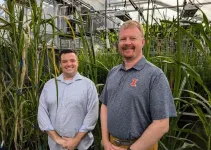(Press-News.org) Drought stress has long been a limiting factor for crop production around the world, a challenge exacerbated by climate change.
For more than a century, scientists have targeted a key plant trait known as water use efficiency (WUE) to help crops grow with less water and avoid suffering from drought stress. Greater WUE can help plants avoid drought stress — but for most crops it’s also associated with lower productivity when water is plentiful.
In a pair of new studies published in the Journal of Experimental Botany, researchers at the Center for Advanced Bioenergy and Bioproducts Innovation (CABBI) used genetic engineering to advance improvement of WUE in climate-friendly C4 bioenergy crops without sacrificing yield, a significant advance for development of a sustainable bioeconomy. CABBI is a Department of Energy (DOE)-funded Bioenergy Research Center.
In the first study, the CABBI team was able to reduce the amount of water escaping from sorghum plants by decreasing the number of stomata, or pores, on the leaf surface, improving WUE without limiting photosynthesis and biomass production. Researchers inserted a gene into the plants that altered their developmental pattern and reduced stomatal density.
“With C4 species, we think we can get a free lunch: We can have improved water use efficiency without having to compromise on how well the plant grows when it does have enough water. And that’s a special case,” said CABBI Director Andrew Leakey, team leader on the two studies.
Researchers in the second study discovered that reducing stomatal density in sugarcane and other C4 crops coincided with the pores opening wider. This offset some of the expected improvement in WUE. The underlying mechanism for this response isn’t fully understood, so the discovery represents a valuable new target for engineering an even more efficient plant.
Together, these findings will help maximize bioenergy feedstock production, aid crops in mitigating the effects of inadequate water supply, and open up new avenues of plant research, said Leakey, the Michael Aiken Chair and Professor in the Departments of Plant Biology and Crop Sciences and the Carl R. Woese Institute of Genomic Biology (IGB) at the University of Illinois Urbana-Champaign.
“It provides an exciting opportunity for new scientific discovery and engineering strategies,” said CABBI Postdoctoral Researcher Daniel Lunn of Plant Biology, IGB, and the Center for Digital Agriculture at Illinois, primary author on the sugarcane study.
Major CABBI collaborators on this research included Feedstock Production Co-PIs Tom Clemente, Eugene W. Price Distinguished Professor of Biotechnology at the University of Nebraska, and Fredy Altpeter, Professor of Agronomy at the University of Florida. The primary author of the sorghum paper was John Ferguson, a former Postdoctoral Researcher at IGB.
During photosynthesis in plants, light energy is captured and used to convert water and carbon dioxide (CO2) into energy-rich organic compounds. Water use efficiency refers to how much photosynthetic carbon gain a plant achieves — or more generally, how much biomass is being produced — relative to the amount of water it uses. In these studies researchers focused on the leaf level, measuring the amount of water and CO2 going in and out through the stomata.
In the vast majority of plants, and the vast majority of efforts to boost WUE in plants, scientists face a tradeoff that stifles crop improvement: Making them more water efficient reduces their inherent productivity, photosynthetic carbon gain, and growth rate. “And so they do better when they don’t have enough water, but they do worse when they do have enough water. From a broader agricultural perspective, that’s a pretty undesirable tradeoff,” Leakey said.
But C4 crops — including sorghum, sugarcane, and miscanthus, CABBI’s target bioenergy crops — are built differently. They have a “fuel-injected version of photosynthesis” that concentrates CO2 inside the leaf before capturing it, “whereas most plants are like a Model T Ford, where they’re running on a naturally aspirated engine,” Leakey said.
Although C4 crops make up only 5% of all plant species, they’re becoming more vital to agricultural production of food, fuel, and fiber. They are important examples of emerging biomass crops, including canes and miscanthus, that sequester carbon while providing a foundation for making bioproducts.
With the new WUE research, “we’re taking the plants that already have an advantage as crops and then potentially making them even better without any drag on carbon gain,” Leakey said.
The team is exploring this engineering approach in more CABBI plant species and fine-tuning the design. Groundbreaking work on miscanthus by other researchers on CABBI’s Feedstock Production team — sequencing the miscanthus genome and developing the first gene-editing techniques — will “allow us to pursue this engineering strategy in a very important, emerging perennial feedstock crop that is capable of sequestering a lot of carbon,” Leakey said.
“Overcoming water limitations to crop production is really very central to achieving our mission of underpinning a profitable, sustainable, and resilient bioeconomy,” he added.
Leaves, roots, and other plant features have evolved to deal with the fundamental tradeoff between carbon gain and water loss in photosynthesis, and those processes have an overriding impact on where crops can grow without irrigation, Leakey said. Developing crops that need 10 percent to 20 percent less water could expand the U.S. rainfed agricultural region further west, and allow farmers in the current growing zone to maintain profitable harvests even in years without sufficient rainfall — a more frequent threat under climate change.
“Part of what we’re trying to do here is maintain increased productivity in times and places where water supply is inadequate,” Leakey said.
Other co-authors on the first paper included Peter Schmuker and Anna Dmitrieva of IGB and CABBI researchers Truyen Quach, Tieling Zhang, Zhengxiang Ge, Natalya Nersesian, and Shirley Sato of the Department of Agronomy and Horticulture at Nebraska. Co-authors on the second paper included Baskaran Kannan of CABBI and Amandine Germon and Alistair Leverett of CABBI and IGB.
END
CABBI team designs efficient bioenergy crops that need less water to grow
2024-09-05
ELSE PRESS RELEASES FROM THIS DATE:
Texas A&M researchers discover that sustained neck exertions change the spine and muscles, causing pain
2024-09-05
Learning new languages, sending emails, attending a virtual class, or speaking to loved ones halfway around the world are just some of the tasks accomplished by touching a button on a smartphone. Unfortunately, the ease and convenience of modern devices have also come with a painful crick in the neck. The sedentary nature of work and prolonged use of hand-held devices and computers have contributed to a sharp increase in neck pain.
While fatigue in neck muscles has long been suspected of causing pain, the actual mechanical changes in the spine and muscles that precede weakness remain an outstanding question.
Now, using high-precision X-ray ...
Air pollution linked to higher risk of infertility in men
2024-09-05
Long term exposure to fine particulate matter (PM2.5) air pollution is linked to a higher risk of infertility in men, whereas road traffic noise is linked to a higher risk of infertility in women over 35, finds a Danish study published by The BMJ today.
If these findings are confirmed in future studies, they could help guide strategies to regulate noise and air pollution to protect the general population from these exposures, say the researchers.
Infertility is a major global health problem affecting one in seven couples trying to conceive.
Several ...
Prostate cancer rates across Europe since 1980 “indicative of overdiagnosis” say experts
2024-09-05
Rates of prostate cancer across Europe since 1980 are “indicative of overdiagnosis”, say researchers in a study published by The BMJ today.
Overdiagnosis refers to the detection of harmless cancers that are unlikely to cause symptoms or death during a patient’s lifetime, which can lead to unnecessary treatment, negative impacts on quality of life, and wasted healthcare resources.
The findings show rapid increases in the number of new cases (incidence) in parallel with uptake of so far predominantly opportunistic ...
Children switch to walking and cycling to school after introduction of London’s Ultra-Low Emission Zone
2024-09-05
Four in ten children in Central London who travelled to school by car switched to more active modes of transport, such as walking, cycling, or public transport, following the introduction of the Ultra-Low Emission Zone (ULEZ), according to new research. In the comparison area with no ULEZ, Luton, only two in ten children made this switch over the same period.
Car travel contributes to air pollution, a major cause of heart and lung diseases including asthma attacks. Beyond this, it limits children's opportunities for physical activity, hindering their development and mental health, and increasing their risk of obesity and chronic illnesses.
Despite ...
Three top ways to stop smoking
2024-09-05
A major new scientific review of evidence published in the journal Addiction has identified three top strategies for quitting smoking:
Varenicline -- a prescription drug sold under the brand names Chantix and Champix among others.
Cytisine -- a plant-based compound available under prescription in the United Kingdom, in Canada as an over-the-counter natural health product (Cravv®) and throughout central and eastern Europe.
Nicotine e-cigarettes.
These work best when combined with behavioural support, ...
Scientific review reveals top three effective ways to stop smoking
2024-09-05
A major new review of evidence by a team of scientists, including a University of Massachusetts Amherst public health researcher, has identified the three best strategies for quitting smoking:
Varenicline – a prescription drug sold under the brand names Chantix and Champix, among others.
Cytisine – a plant-based compound not widely available in the U.S. but sold as an over-the-counter natural health product (Cravv®) in Canada and throughout Central and Eastern Europe, and available under prescription in the United Kingdom.
Nicotine e-cigarettes.
The review, published ...
HudsonAlpha researchers awarded NIH grant to identify genetic contributors to rare diseases in children
2024-09-05
As genetic sequencing technology becomes more accessible and efficient, researchers have made significant strides in understanding the genetic underpinnings of various diseases. This knowledge has led to a surge in clinical applications of genetic testing, offering hope and improved outcomes for individuals affected by many genetic diseases and disorders. Despite these successes, scientists continue to try to improve genetic testing technologies, because many individuals with rare diseases remain undiagnosed even after current state-of-the-art genomic testing.
Scientists at the HudsonAlpha Institute for Biotechnology ...
The signals in your brain that tell you when It’s time to move
2024-09-05
A new study, published in Nature Communications this week, led by Jake Gavenas PhD, while he was a PhD student at the Brain Institute at Chapman University, and co-authored by two faculty members of the Brain Institute, Uri Maoz and Aaron Schurger, examines how the brain initiates spontaneous actions. In addition to demonstrating how spontaneous action emerges without environmental input, this study has implications for the origins of slow ramping of neural activity before movement onset—a commonly-observed but poorly understood ...
Hudson River Foundation awards $1.7 million to Cary Institute for river monitoring program
2024-09-04
(Millbrook, NY) The Hudson River Foundation for Science and Environmental Research (HRF) has awarded $1.7 million to Cary Institute of Ecosystem Studies to monitor the Hudson River’s lower food web for three years. The project is an integral component of the $6.5 million Hudson River Ecosystem Monitoring Program, a collaboration of HRF and New York State Department of Environmental Conservation (DEC) to develop and implement the next generation comprehensive ecosystem monitoring program on the Hudson.
Cary’s Chris Solomon will lead the Interim Lower Food Web Survey to provide ...
$7.5 million grant to guard against AI-driven misinformation
2024-09-04
BLOOMINGTON, Ind. — Indiana University researchers will lead a multi-institutional team of experts in areas such as informatics, psychology, communications and folklore to assess the role that artificial intelligence may play in strengthening the influence of online communications — including misinformation and radicalizing messages — under a $7.5 million grant from the U.S. Department of Defense.
The project is one of 30 recently funded by the department’s Multidisciplinary University ...




